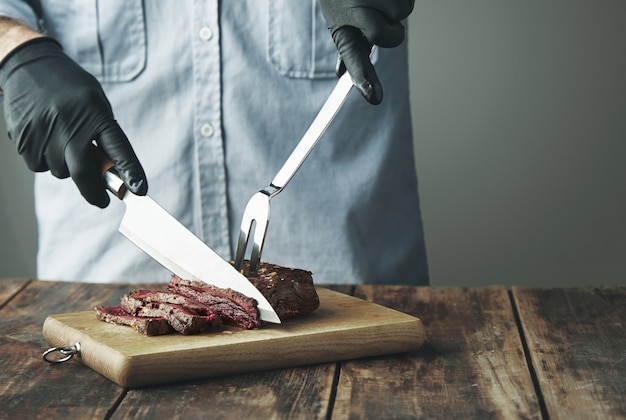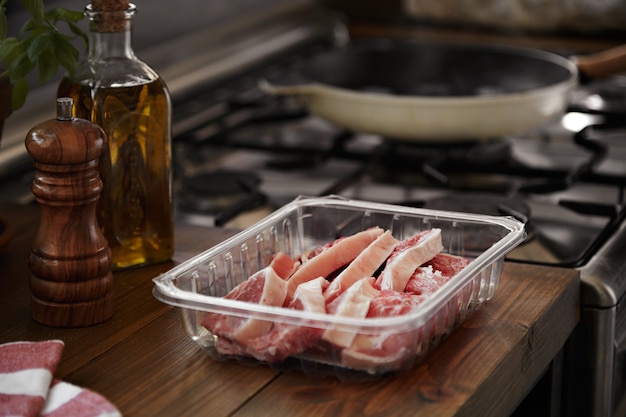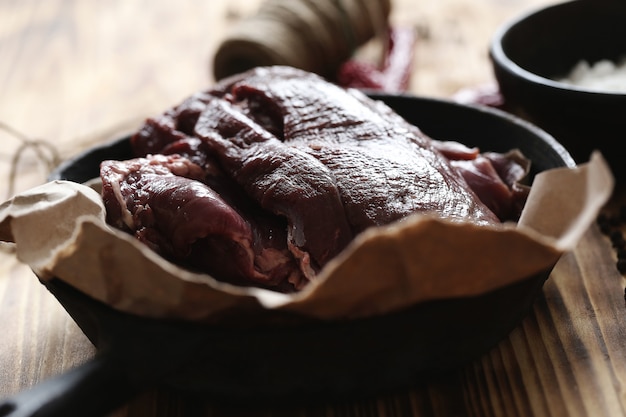(Part 1) The Science Behind Those tender ribs: Collagen and Temperature

1. Collagen: The Key to Tenderness
pork ribs are primarily composed of collagen, a protein that gives them that tough, chewy texture when raw. But here's the magic: as you heat up those ribs, the collagen transforms into gelatin. Gelatin, that jiggly, delicious stuff you find in desserts, is what makes those ribs so tender and succulent.2. Temperature is King: Reaching the Magic Number
The key to unleashing that collagen magic lies in reaching the right temperature. The magic number we're aiming for is 190°F (88°C) in the thickest part of the rib. This temperature ensures that the collagen breaks down completely, giving us those incredibly tender, fall-off-the-bone results.3. cooking time: A Matter of Patience
The amount of time it takes to achieve that perfect temperature depends on a few factors like the size of the ribs, the cooking method, and your desired level of tenderness. But as a general rule, expect to spend at least 3-4 hours cooking your ribs, and you might even want to go for 6-8 hours for a super-tender result.4. The Rest: A Crucial Step
Even after your ribs hit that magic 190°F (88°C), they need some time to rest. Think of it as a chance for those flavorful juices to redistribute throughout the meat. A 30-minute rest period is the perfect way to ensure a juicy, flavorful bite.(Part 2) Cooking Methods: Grilling, Smoking, and Oven-Baking

1. Grilling: The Quick and Flavorful Option
grilling ribs offers a quick and flavorful way to achieve that crispy crust and smoky flavor. The high heat of the grill helps to caramelize the sugars in your rub, creating a delicious crust, while the indirect heat allows the ribs to cook slowly and evenly.Here's a step-by-step guide for grilling ribs:
- Prep the Ribs: Start by patting those ribs dry with a paper towel. Then, generously rub them with your favourite BBQ rub, making sure to get it into all the crevices.
- Preheat the Grill: Preheat your grill to medium-high heat (around 350-400°F or 175-205°C). This will ensure a nice, even sear on the ribs.
- Sear the Ribs: Place the ribs bone-side down on the hot grill and cook for about 5 minutes. This will create that delicious, crispy crust that everyone loves.
- Move to Indirect Heat: Once the ribs are seared, move them to the indirect heat zone of your grill, away from the direct flames. Close the lid and cook for about 3-4 hours, adding your favourite bbq sauce during the last hour of cooking.
- Check the Temperature: Insert a meat thermometer into the thickest part of the ribs, ensuring it doesn't touch bone. Aim for an internal temperature of 190°F (88°C) for perfectly tender and juicy ribs.
- Rest and Enjoy: Remove the ribs from the grill and let them rest for about 30 minutes, covered with foil. This allows the juices to redistribute throughout the meat, ensuring a more flavorful bite. Then, slice the ribs and serve them with your favourite sides.
2. Smoking: The Low and Slow Way to Tenderness
smoking ribs is a time-consuming process, but the results are truly worth the effort. The low and slow heat of a smoker allows the ribs to cook slowly and evenly, resulting in tender, juicy meat that's bursting with smoky flavor.Here's a step-by-step guide for smoking ribs:
- Prep the Ribs: Pat the ribs dry and generously rub them with your favorite BBQ rub.
- Preheat the Smoker: Preheat your smoker to 225°F (107°C), and make sure to maintain a consistent temperature throughout the smoking process. This will ensure even cooking and prevent the ribs from drying out.
- Smoke the Ribs: Place the ribs on the smoker, ensuring they have plenty of space around them for even smoke circulation. Smoke the ribs for 4-6 hours, adding your favourite BBQ sauce during the last hour of cooking.
- Check the Temperature: Use a meat thermometer to check the internal temperature of the ribs. Aim for 190°F (88°C) for a tender and juicy result.
- Rest and Enjoy: Remove the ribs from the smoker and let them rest for about 30 minutes before slicing and serving. This allows the juices to redistribute evenly, making for a more succulent bite.
3. Oven-Baking: A Convenient Option for Ribs
Oven-baking is a great option for those who don't have a grill or smoker. It's a convenient and straightforward method that produces juicy and tender ribs.Here's how to bake ribs:
- Prep the Ribs: Pat the ribs dry and apply your favourite BBQ rub. You can also wrap the ribs in foil to lock in moisture and prevent them from drying out.
- Preheat the Oven: Preheat your oven to 300°F (150°C). This low temperature will allow the ribs to cook slowly and evenly.
- Bake the Ribs: Place the ribs in a roasting pan and bake for 3-4 hours, basting with your favourite BBQ sauce during the last hour of cooking. If you’re using foil, remove it during the last 30 minutes to allow the ribs to crisp up.
- Check the Temperature: Use a meat thermometer to check the internal temperature of the ribs. Aim for 190°F (88°C) for a tender and juicy result.
- Rest and Enjoy: Remove the ribs from the oven and let them rest for about 30 minutes before slicing and serving. Allowing the ribs to rest will help to redistribute the juices and make them even more tender and flavorful.
(Part 3) The Importance of Rest: Let Those Juices Redistribute

1. The Juices Redistribute: A More Flavorful Bite
As the ribs cook, the juices naturally rise to the surface. Resting allows these juices to redistribute evenly throughout the meat, ensuring a moist and flavorful bite.2. Even More Tenderness: Relaxing Muscle Fibers
Resting allows the muscle fibers to relax and further break down, resulting in even more tender and juicy ribs.3. Easier Slicing: A Smoother Experience
Resting helps the ribs firm up slightly, making them easier to slice without falling apart. This makes for a more pleasant and satisfying experience.(Part 4) How to Check the Temperature: A Thermometer Is Your Best Friend
To ensure your ribs are cooked to perfection, a meat thermometer is an absolute essential. It's the only reliable way to accurately measure the internal temperature of your ribs.1. Inserting the Thermometer: Don't Touch Bone
Insert the thermometer into the thickest part of the ribs, ensuring it doesn't touch bone. The thermometer should be inserted at a 45-degree angle.2. Reading the Thermometer: Wait for Stability
Wait for the thermometer to stabilize. Aim for a minimum internal temperature of 190°F (88°C). If the temperature is below, continue cooking until it reaches the desired temperature.3. Types of Thermometers: Choosing the Right Tool
You can choose from a variety of thermometers, including instant-read thermometers, probe thermometers, and wireless thermometers.Here's a brief comparison of the different types:
| Type of Thermometer | Advantages | Disadvantages |
|---|---|---|
| Instant-Read Thermometer | Fast and convenient, affordable | Requires constant monitoring, less accurate than probe thermometers |
| Probe Thermometer | More accurate than instant-read thermometers, allows for continuous monitoring | Can be more expensive, requires a longer cooking time |
| Wireless Thermometer | Allows for remote monitoring, eliminates the need to constantly check the ribs | Can be more expensive, requires batteries |
No matter which type you choose, make sure your thermometer is calibrated correctly for accurate readings.
(Part 5) The Art of BBQ Sauce: A Symphony of Flavor
No rib experience is complete without a generous slathering of BBQ sauce. It's the final touch that transforms a good rib into a truly sensational one.1. Choosing the Right Sauce: Finding Your Flavor Profile
With so many BBQ sauce options out there, choosing the right one can be daunting. Consider your personal preferences and the flavor profile of your ribs. Do you prefer a sweet, smoky, tangy, or spicy sauce?Here are some popular BBQ sauce types:
- Sweet: Often made with brown sugar, honey, or molasses.
- Smoky: Includes ingredients like smoked paprika, liquid smoke, or even mesquite.
- Tangy: Often features vinegar, lemon juice, or mustard.
- Spicy: Contains chili peppers, hot sauce, or cayenne pepper.
Don't be afraid to experiment and try different sauces until you find your perfect match.
2. When to Apply BBQ Sauce: Crispy Crust vs. Glazed Finish
For a crispy crust, apply BBQ sauce during the last 30-60 minutes of cooking. However, if you prefer a more glazed finish, apply sauce throughout the cooking process, basting the ribs every hour or so.3. Using a Basting Brush: Even Distribution for Maximum Flavor
Use a basting brush to evenly distribute the sauce across the ribs. You can also use a spray bottle for a less messy application.4. Experiment with Flavors: Create Your Own Sauce
Don't be afraid to experiment with different BBQ sauces. You can even make your own sauce at home, combining your favourite ingredients for a personalized taste.(Part 6) Let's Talk Ribs: A Quick Look at Different Types
Did you know there are different types of ribs? It's true! While baby back ribs are the most popular, there are other delicious options out there, each with its unique characteristics.1. baby back ribs: The Classic Choice
These ribs are known for their tender meat and flavorful bone-in section. They're usually cut from the upper part of the hog and have a shorter cooking time than spare ribs.2. Spare Ribs: Meaty and Flavorful
These ribs come from the lower part of the hog and are typically larger and meatier than baby back ribs. They have a thicker layer of fat and a more pronounced bone-in section.3. St. Louis Style Ribs: Uniform and Delicious
These ribs are made by removing the tougher membrane from the spare ribs. They're known for their rectangular shape and more uniform thickness.4. Country Style Ribs: Not Technically Ribs
These ribs are not technically ribs, but rather a cut of pork shoulder that's been shaped into a rib-like form. They're typically cut thicker than other ribs and are known for their tenderness.(Part 7) FAQs: Your Rib-Related Questions Answered
I've gathered some of the most common rib-related questions you might have.1. What's the Best Way to Cook Ribs?
Honestly, there's no "best" way. It really comes down to your personal preference and what works best for you. Grilling, smoking, and oven-baking are all fantastic methods.2. How Long Do I Need to Cook Ribs?
The cooking time depends on the type of ribs, the cooking method, and your desired level of tenderness. Expect to cook ribs for at least 3-4 hours, and possibly up to 6-8 hours for super-tender ribs.3. How Do I Know When Ribs Are Done?
The best way to determine if ribs are done is to use a meat thermometer. Aim for an internal temperature of 190°F (88°C) for a tender and juicy result.4. What Happens If I Overcook My Ribs?
Overcooked ribs will be dry and tough. If you're unsure, it's best to undercook them slightly and then rest them for a longer period of time to allow the juices to redistribute.5. What's the Best Way to Serve Ribs?
Ribs are delicious served on their own or with a variety of sides, such as mashed potatoes, coleslaw, mac and cheese, or baked beans. You can also create a BBQ platter with different meats, sauces, and sides.(Part 8) The Rib Revelation: A culinary journey of Discovery
As I said at the beginning, cooking ribs has been a journey for me. It's a journey of experimentation, discovery, and, most importantly, deliciousness. Every time I cook a rack of ribs, I learn something new. I try different rubs, sauces, and cooking methods, constantly searching for the perfect recipe. But the truth is, the perfect rib is often a matter of personal preference. So don't be afraid to experiment, to explore different flavours and techniques. The journey of discovering the perfect rib is just as much fun as the final result. Now, go forth and cook some ribs! And remember, even if they don't turn out exactly how you envisioned, there's always room for improvement. After all, cooking is about learning, growing, and enjoying the process.Happy cooking!
Everyone is watching

Corn on the Cob: The Ultimate Guide to Perfectly Cooked Ears
Healthy MealsAh, corn on the cob. Just the name evokes images of sunny days, barbecues, and that sweet, juicy flavour that ...

Scallops: The Ultimate Guide to Perfect Cooking
Healthy MealsAh, scallops. Those delicate, sweet, and utterly delicious morsels of the sea. They hold a special place in my...

Spaghetti Squash: The Ultimate Guide to Cooking and Serving
Healthy MealsRemember that time you saw spaghetti squash at the supermarket, looking all bumpy and strange, and thought, "W...

Salmon Cooking Times: Perfect Guide for Every Recipe
Healthy MealsLet me tell you, cooking salmon is an art form. It's all about getting that perfect balance: juicy and tender,...

Ham Cooking Time: How Long to Bake, Smoke, or Boil a Delicious Ham
Healthy MealsAh, ham. It's a classic, isn't it? A real crowd-pleaser, especially around holidays. And when done right, it'...
